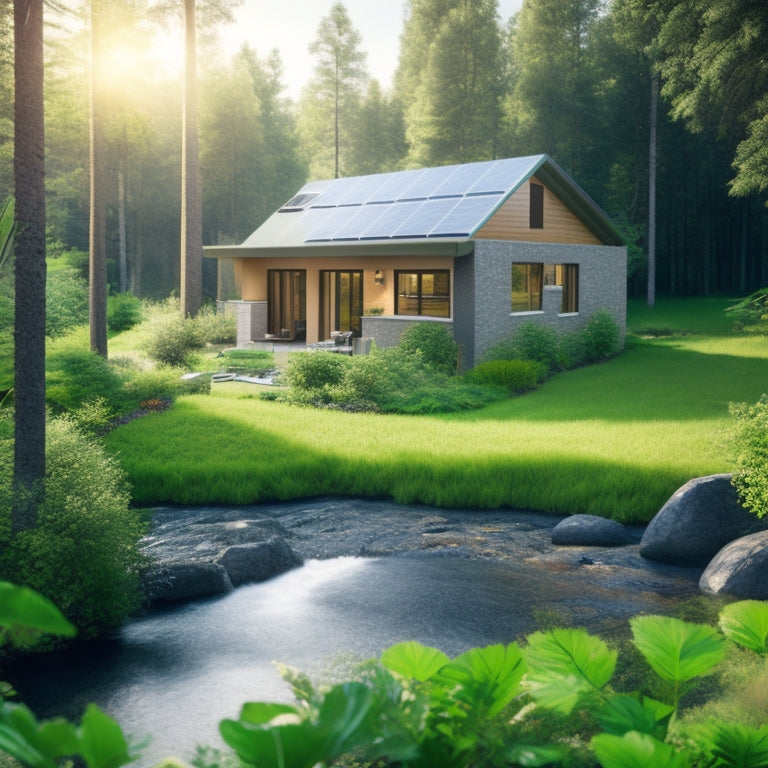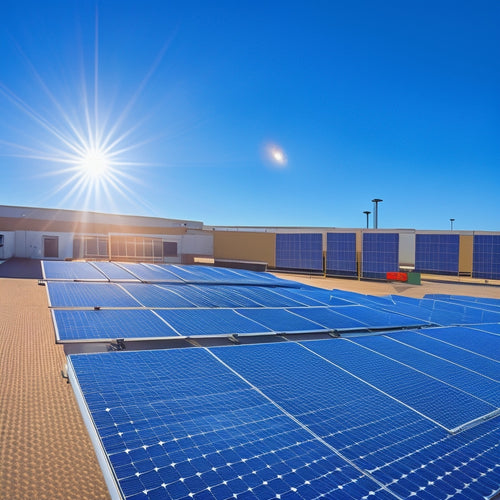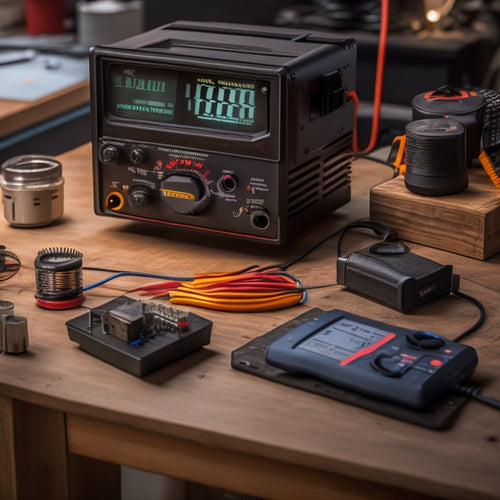
10 Best Home Renewable Energy Solutions
Share
By investing in the right renewable energy solutions, you can greatly reduce your reliance on fossil fuels, lower your energy bills, and increase your property value. The top 10 home renewable energy solutions offer a pathway to energy independence and a more sustainable future. You'll be able to identify inefficiencies, upgrade your electrical infrastructure, and shift to renewable sources like solar or wind power. With energy audits, you'll understand your energy consumption patterns, allowing you to select the most suitable solutions for your needs. Whether you're looking to combat climate change or enhance your property's appeal, the right renewable energy solutions are just a step ahead.
At a Glance
- Investing in renewable energy systems enables energy independence, reduces reliance on external providers, and promotes autonomy.
- Solar energy solutions can raise property value by up to 17%, making them a worthwhile investment for homeowners.
- Advanced monitoring systems allow real-time tracking of energy production, helping homeowners understand consumption patterns and optimize energy usage.
- Conducting energy audits identifies inefficient appliances and habits, leading to opportunities for energy efficiency improvements and reduced carbon emissions.
- Key renewable energy technologies include solar, wind, and geothermal power, each requiring proper assessment of energy needs and property layout for optimal installation.
Zero Energy Bills Possible
By investing in a thorough renewable energy system, you can achieve energy independence, generating all the power your home needs without relying on the grid.
This setup not only eliminates your energy bills but also greatly reduces your carbon footprint, making a substantial impact on the environment.
Home Energy Independence solutions, such as off-grid living, address concerns about power outages and natural disasters, providing a reliable source of power and giving homeowners control over their energy needs.
Energy Independence Achieved
You've probably dreamed of the day when you can say goodbye to hefty energy bills and hello to energy independence. With the right renewable energy solutions, you can achieve energy autonomy and self-sufficiency. This means relying less on the grid and more on your own clean energy sources.
By utilizing solar, wind, or geothermal power, you can generate electricity on-site and reduce your reliance on external energy providers. For instance, an All in One Solar Power System integrated solar solutions can provide a streamlined, plug-and-play experience that simplifies the shift to renewable energy.
To achieve energy independence, you'll need to assess your energy consumption and determine the right mix of renewable energy sources for your home. This may involve installing solar panels, wind turbines, or geothermal systems, depending on your location and energy needs.
You may also need to upgrade your electrical infrastructure to accommodate the new energy sources. With the right system design and installation, you can enjoy energy independence and greatly reduce your energy bills.
Reduced Carbon Footprint
A reduced carbon footprint is a significant advantage of adopting home renewable energy solutions. By utilizing energy from natural sources like solar, wind, and geothermal, you're reducing your reliance on fossil fuels and lowering your carbon emissions. This not only helps combat climate change but also contributes to a cleaner, healthier environment.
With renewable energy, you can implement carbon offset strategies to neutralize your carbon footprint further. For instance, by installing an extensive solar power system, you can eliminate the worry of rising electricity bills and solve the problem of sky-high energy costs that strain your budget every month.
You can invest in reforestation projects or renewable energy projects that offset your energy consumption.
Increases Property Value
You're likely to see a significant increase in your property's value when you invest in renewable energy upgrades, as they're highly sought after by environmentally conscious homebuyers.
By incorporating solar energy solutions into your home, you can enhance its appeal to potential buyers who prioritize reducing their carbon footprint.
In fact, studies have shown that sustainable home investments can increase property value by up to 10%.
Renewable Energy Upgrades
Three out of four homeowners believe that installing renewable energy upgrades increases their property value. You're likely one of them, and you're right to think so. Renewable energy upgrades can greatly enhance your property's appeal and resale value.
One of the most popular upgrades is solar panel installation, which can raise your property value by up to 17%. Wind turbine options are also gaining traction, particularly for rural properties with ample space.
When considering renewable energy upgrades, it's vital to assess your energy needs and property layout. You'll want to determine the best placement for your solar panels or wind turbines to maximize energy production.
Additionally, you'll need to make sure that your electrical infrastructure can support the upgrade. It's important to work with a reputable installer who can guide you through the process and provide a thorough assessment of your property's potential.
Sustainable Home Investments
Beyond renewable energy upgrades, various sustainable home investments can greatly enhance your property's value.
These investments not only contribute to a more eco-friendly living space but also increase your home's appeal to potential buyers if you decide to sell in the future.
By incorporating eco-friendly renovations, such as energy-efficient windows, sustainable building materials, and rainwater harvesting systems, you can considerably elevate your property's value.
In addition, you can investigate green financing options, like energy-efficient mortgages or Property Assessed Clean Energy (PACE) financing, to fund your sustainable home investments.
These financing options often offer more favorable terms, such as lower interest rates or longer repayment periods, making it easier to invest in your home's sustainability.
Grid Tie Inverters Explained
You'll need a well-designed inverter system to efficiently convert the DC power generated by your renewable energy system into AC power that's compatible with the grid.
For homeowners evaluating energy storage solutions, such as the Tesla Powerwall, a reliable inverter system is essential.
A key aspect of this system is the grid tie inverter, which synchronizes your renewable energy output with the grid's frequency and voltage.
You'll also want to take into account the energy monitoring capabilities of your inverter, which will help you track your energy production and identify areas for improvement.
Inverter System Design
When designing an inverter system, an essential aspect to take into account is the grid tie inverter, which serves as the interface between your renewable energy source and the electrical grid. You'll need to contemplate the inverter's efficiency, as it directly affects the amount of energy you can feed back into the grid. There are different types of inverters, including string inverters, microinverters, and power optimizers, each with its own strengths and weaknesses.
| Inverter Feature | Description |
|---|---|
| Inverter Efficiency | Measures the percentage of DC power converted to AC power |
| Inverter Compatibility | Confirm compatibility with your renewable energy source and electrical grid |
| Inverter Sizing | Correct sizing guarantees peak energy production and reduces waste |
| Inverter Maintenance | Regular maintenance guarantees peak performance and prolongs lifespan |
| Inverter Warranties | Look for extensive warranties that cover parts and labor |
When selecting an inverter, reflect on factors such as inverter technology, features, and upgrades. You'll also need to confirm proper inverter installation and maintenance to maximize energy production and minimize downtime. By carefully designing your inverter system, you can enjoy a reliable and efficient renewable energy solution that provides you with the freedom and independence you desire.
Energy Monitoring Capabilities
Having optimized your inverter system design, you can now focus on utilizing the full potential of your grid tie inverter through advanced energy monitoring capabilities. This permits you to track your energy production in real-time, identifying areas for improvement and maximizing your renewable energy output.
With smart meters integrated into your system, you'll have access to detailed energy analytics, allowing you to monitor your energy consumption patterns and adjust your usage accordingly. This data-driven approach enables you to make informed decisions about your energy management, reducing your reliance on the grid and increasing your energy independence.
You'll be able to track key performance indicators such as energy yield, system efficiency, and grid stability. This granular level of understanding allows you to identify potential issues before they affect your energy production, ensuring your system operates at peak performance.
Assess Your Energy Consumption
You need to understand your energy usage patterns to determine the right size and type of renewable energy system for your home.
Start by tracking your daily energy consumption in kilowatt-hours (kWh) to identify peak usage times and high-energy appliances.
Consider investing in residential solar panels to reduce your reliance on the grid and pair them with a battery storage system to store excess energy for later use.
Energy Usage Patterns
To make the most of renewable energy solutions, one must first understand their energy usage patterns, as it's essential to identify areas of improvement and prioritize energy efficiency.
You can start by analyzing your past energy bills to identify consumption trends. Look for peak usage hours, days, and seasons to determine when you're using the most energy. This will help you pinpoint areas where you can optimize your energy usage.
You should also consider conducting an energy audit to identify energy-wasting habits and inefficient appliances. This can be done by hiring a professional or using DIY energy audit kits.
The audit will help you identify opportunities to improve energy efficiency, such as sealing air leaks, upgrading to energy-efficient lighting, and optimizing your HVAC system.
Daily Energy Consumption
Daily energy consumption patterns vary greatly from one household to another, depending on factors such as family size, lifestyle, and geographic location.
To assess your energy consumption, you need to understand your daily energy usage habits. Start by identifying the times of day when your energy usage peaks. Are you a morning person who relies heavily on coffee makers and hair dryers, or do you work from home and use energy-intensive devices like computers and printers throughout the day?
Take note of the appliances and devices you use regularly, and their corresponding energy ratings. This will help you pinpoint areas where you can improve energy efficiency. For instance, switching to energy-efficient LED bulbs or replacing old appliances with Energy Star-rated ones can greatly reduce your energy consumption.
Analyze your consumption habits and identify opportunities to optimize your energy usage. By understanding your daily energy consumption patterns, you can make informed decisions about which renewable energy solutions will work best for your household, ultimately giving you more control over your energy costs and contributing to a more sustainable future.
Lower Carbon Footprint Guaranteed
By shifting to renewable energy sources, you'll greatly reduce your reliance on fossil fuels, slashing your carbon emissions and mitigating climate change.
This change will also decrease your energy dependency, freeing you from the volatile prices of non-renewable energy sources.
As you opt for clean energy, you'll be taking an essential step towards a more sustainable future, one that's kinder to the environment and your wallet.
Reduce Energy Dependency
Nearly 70% of the average American's energy consumption comes from fossil fuels, making energy dependency a significant contributor to our collective carbon footprint.
You can break free from this dependency by adopting energy alternatives and sustainable practices in your home. Start by conducting an energy audit to identify areas of inefficiency.
Then, switch to energy-efficient appliances and lighting to reduce your energy consumption. Consider investing in renewable energy sources like solar or wind power to generate electricity.
You can also reduce your reliance on fossil fuels by using energy storage systems like batteries to store excess energy generated by your renewable sources.
Frequently Asked Questions
Can I Install Renewable Energy Systems Myself?
You can attempt a DIY solar installation, but be aware that you'll face installation challenges, such as ensuring electrical connections meet safety codes and optimizing system performance, which may lead to reduced energy output and efficiency.
How Long Do Solar Panels Typically Last?
You're about to unfasten a century-long power party, as solar panels typically last an astonishing 30-40 years or more, with most manufacturers backing their products with 25-year warranties, guaranteeing you'll be utilizing free energy for decades to come!
Are There Any Renewable Energy Solutions for Apartments?
You're not limited to traditional homeownership to access renewable energy! You can investigate community initiatives, wind energy co-ops, or solar options like shared panels or community solar gardens, and prioritize energy efficiency in your apartment to reduce your carbon footprint.
Do Renewable Energy Systems Require Regular Maintenance?
You'll need to perform routine maintenance to guarantee your renewable energy system runs at its best, as neglecting maintenance can decrease system efficiency by up to 20%. The maintenance frequency depends on the system type, but expect to perform checks every 3-6 months.
Can I Sell Excess Energy Back to the Grid?
You can sell excess energy back to the grid through net metering, where utilities measure your excess production and credit you; many energy buyback policies allow you to offset your energy bills or even earn revenue.
Explore More
You've investigated the top 10 home renewable energy solutions, and now it's time to take action. With the right system, you can kiss zero energy bills goodbye. In fact, did you know that homes with solar panels sell for an average of $15,000 more than similar homes without them? By investing in renewable energy, you'll not only reduce your carbon footprint but also enhance your property value. So, what are you waiting for? Start utilizing the power of nature and reap the benefits for years to come.
Related Posts
-
Average Lifespan of Solar Battery Banks
The average lifespan of solar battery banks generally ranges from 5 to 15 years. This variation mainly stems from the...
-

Essential Solar Panel Mounts for Commercial Properties
When it comes to essential solar panel mounts for your commercial property, durability and wind resistance are key fa...
-

Key Features of a DC to AC Converter
A DC to AC converter features high efficiency and conversion rates, which reduce energy costs and improve performance...

